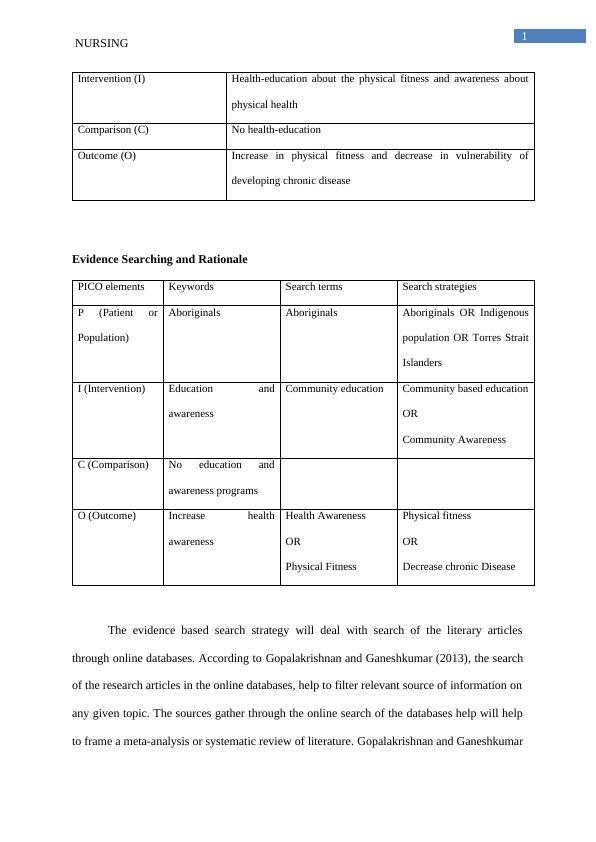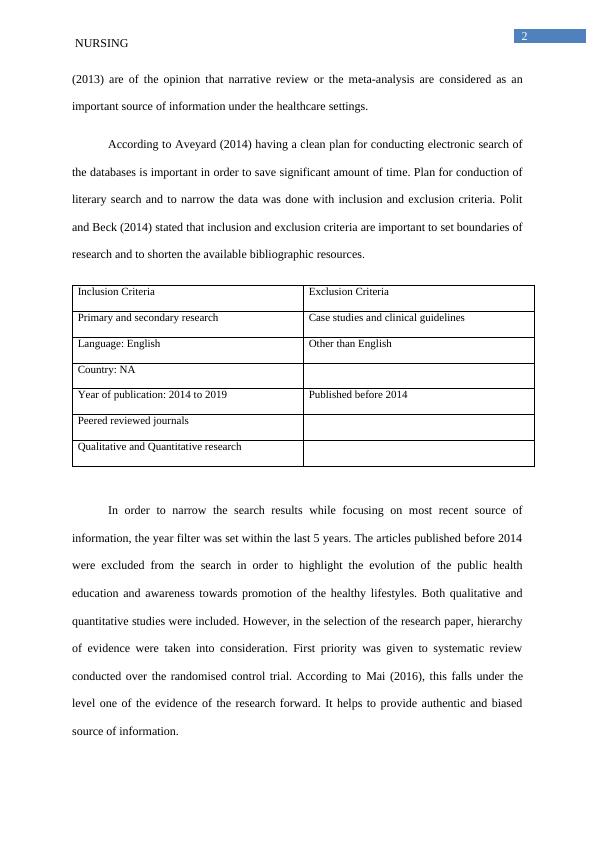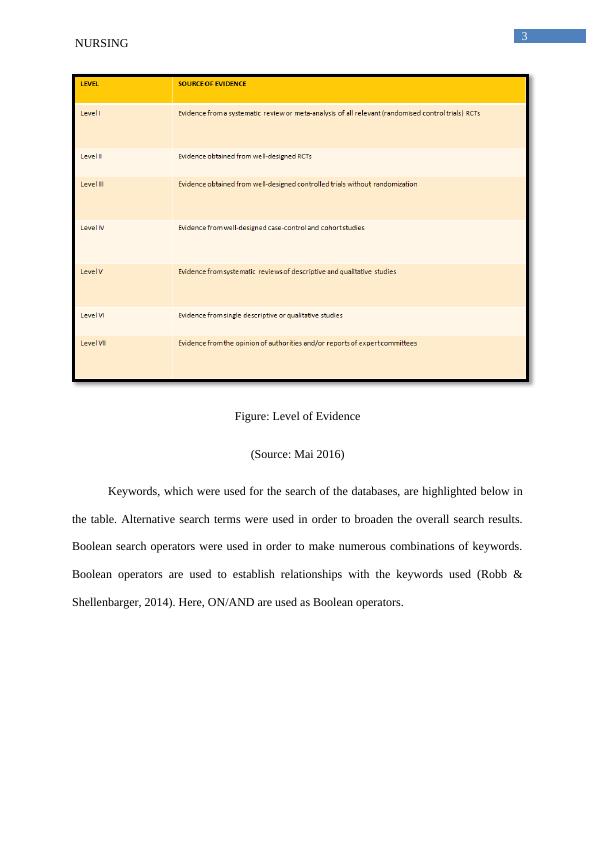Physical Inactivity and Obesity among Aboriginals: An Evidence-Based Nursing Report
Added on 2023-04-21
11 Pages2652 Words113 Views
NURSING
Clinical Issue
The main clinical issue that will be highlighted in this evidence-based nursing report
is physical inactivity leading to obesity among the aboriginals. According to the PHN
Darling Downs and West Moreton, an Australian Government Initiative (2018), there is no or
little exercise among the people who are aged 18 years and above. The Darling Downs and
West Moreton PHN secure the first position in Australia for the highest rate of the physical
inactivity. As per the reports of the Australian Burden of Disease Study, high body mass
index (BMI) is the single leading risks factors for increasing the disease burden by 7%.
Increase in the trend of obesity increases the disease burden for endocrine disorders,
cardiovascular disease, kidney or renal complication, urinary disease and cancer. This disease
cumulates the overall disease burden by 31%. The trend of obesity is higher among the
aboriginals. According to Health Assessment Needs (2018) Darling Downs and West
Moreton have highest population of aboriginals with more than 500 residents in comparison
to the entire state (Queensland). The majority of the aboriginals who resides in Darling
Downs and West Moreton are obese and the main reason highlight behind this is lack of
physical activity. As per the evidence-based practice it is the role of the nursing professional
to educate the youth for indigenous and non-indigenous population among the importance of
physical fitness and combating obesity.
Clinical Question
How the evidence-based practice of education from nurses helps to increase the health
awareness among the aboriginals about the physical fitness and thereby helping to decrease
obesity?
Population (P) Aboriginals
Clinical Issue
The main clinical issue that will be highlighted in this evidence-based nursing report
is physical inactivity leading to obesity among the aboriginals. According to the PHN
Darling Downs and West Moreton, an Australian Government Initiative (2018), there is no or
little exercise among the people who are aged 18 years and above. The Darling Downs and
West Moreton PHN secure the first position in Australia for the highest rate of the physical
inactivity. As per the reports of the Australian Burden of Disease Study, high body mass
index (BMI) is the single leading risks factors for increasing the disease burden by 7%.
Increase in the trend of obesity increases the disease burden for endocrine disorders,
cardiovascular disease, kidney or renal complication, urinary disease and cancer. This disease
cumulates the overall disease burden by 31%. The trend of obesity is higher among the
aboriginals. According to Health Assessment Needs (2018) Darling Downs and West
Moreton have highest population of aboriginals with more than 500 residents in comparison
to the entire state (Queensland). The majority of the aboriginals who resides in Darling
Downs and West Moreton are obese and the main reason highlight behind this is lack of
physical activity. As per the evidence-based practice it is the role of the nursing professional
to educate the youth for indigenous and non-indigenous population among the importance of
physical fitness and combating obesity.
Clinical Question
How the evidence-based practice of education from nurses helps to increase the health
awareness among the aboriginals about the physical fitness and thereby helping to decrease
obesity?
Population (P) Aboriginals

1
NURSING
Intervention (I) Health-education about the physical fitness and awareness about
physical health
Comparison (C) No health-education
Outcome (O) Increase in physical fitness and decrease in vulnerability of
developing chronic disease
Evidence Searching and Rationale
PICO elements Keywords Search terms Search strategies
P (Patient or
Population)
Aboriginals Aboriginals Aboriginals OR Indigenous
population OR Torres Strait
Islanders
I (Intervention) Education and
awareness
Community education Community based education
OR
Community Awareness
C (Comparison) No education and
awareness programs
O (Outcome) Increase health
awareness
Health Awareness
OR
Physical Fitness
Physical fitness
OR
Decrease chronic Disease
The evidence based search strategy will deal with search of the literary articles
through online databases. According to Gopalakrishnan and Ganeshkumar (2013), the search
of the research articles in the online databases, help to filter relevant source of information on
any given topic. The sources gather through the online search of the databases help will help
to frame a meta-analysis or systematic review of literature. Gopalakrishnan and Ganeshkumar
NURSING
Intervention (I) Health-education about the physical fitness and awareness about
physical health
Comparison (C) No health-education
Outcome (O) Increase in physical fitness and decrease in vulnerability of
developing chronic disease
Evidence Searching and Rationale
PICO elements Keywords Search terms Search strategies
P (Patient or
Population)
Aboriginals Aboriginals Aboriginals OR Indigenous
population OR Torres Strait
Islanders
I (Intervention) Education and
awareness
Community education Community based education
OR
Community Awareness
C (Comparison) No education and
awareness programs
O (Outcome) Increase health
awareness
Health Awareness
OR
Physical Fitness
Physical fitness
OR
Decrease chronic Disease
The evidence based search strategy will deal with search of the literary articles
through online databases. According to Gopalakrishnan and Ganeshkumar (2013), the search
of the research articles in the online databases, help to filter relevant source of information on
any given topic. The sources gather through the online search of the databases help will help
to frame a meta-analysis or systematic review of literature. Gopalakrishnan and Ganeshkumar

2
NURSING
(2013) are of the opinion that narrative review or the meta-analysis are considered as an
important source of information under the healthcare settings.
According to Aveyard (2014) having a clean plan for conducting electronic search of
the databases is important in order to save significant amount of time. Plan for conduction of
literary search and to narrow the data was done with inclusion and exclusion criteria. Polit
and Beck (2014) stated that inclusion and exclusion criteria are important to set boundaries of
research and to shorten the available bibliographic resources.
Inclusion Criteria Exclusion Criteria
Primary and secondary research Case studies and clinical guidelines
Language: English Other than English
Country: NA
Year of publication: 2014 to 2019 Published before 2014
Peered reviewed journals
Qualitative and Quantitative research
In order to narrow the search results while focusing on most recent source of
information, the year filter was set within the last 5 years. The articles published before 2014
were excluded from the search in order to highlight the evolution of the public health
education and awareness towards promotion of the healthy lifestyles. Both qualitative and
quantitative studies were included. However, in the selection of the research paper, hierarchy
of evidence were taken into consideration. First priority was given to systematic review
conducted over the randomised control trial. According to Mai (2016), this falls under the
level one of the evidence of the research forward. It helps to provide authentic and biased
source of information.
NURSING
(2013) are of the opinion that narrative review or the meta-analysis are considered as an
important source of information under the healthcare settings.
According to Aveyard (2014) having a clean plan for conducting electronic search of
the databases is important in order to save significant amount of time. Plan for conduction of
literary search and to narrow the data was done with inclusion and exclusion criteria. Polit
and Beck (2014) stated that inclusion and exclusion criteria are important to set boundaries of
research and to shorten the available bibliographic resources.
Inclusion Criteria Exclusion Criteria
Primary and secondary research Case studies and clinical guidelines
Language: English Other than English
Country: NA
Year of publication: 2014 to 2019 Published before 2014
Peered reviewed journals
Qualitative and Quantitative research
In order to narrow the search results while focusing on most recent source of
information, the year filter was set within the last 5 years. The articles published before 2014
were excluded from the search in order to highlight the evolution of the public health
education and awareness towards promotion of the healthy lifestyles. Both qualitative and
quantitative studies were included. However, in the selection of the research paper, hierarchy
of evidence were taken into consideration. First priority was given to systematic review
conducted over the randomised control trial. According to Mai (2016), this falls under the
level one of the evidence of the research forward. It helps to provide authentic and biased
source of information.

3
NURSING
Figure: Level of Evidence
(Source: Mai 2016)
Keywords, which were used for the search of the databases, are highlighted below in
the table. Alternative search terms were used in order to broaden the overall search results.
Boolean search operators were used in order to make numerous combinations of keywords.
Boolean operators are used to establish relationships with the keywords used (Robb &
Shellenbarger, 2014). Here, ON/AND are used as Boolean operators.
NURSING
Figure: Level of Evidence
(Source: Mai 2016)
Keywords, which were used for the search of the databases, are highlighted below in
the table. Alternative search terms were used in order to broaden the overall search results.
Boolean search operators were used in order to make numerous combinations of keywords.
Boolean operators are used to establish relationships with the keywords used (Robb &
Shellenbarger, 2014). Here, ON/AND are used as Boolean operators.

End of preview
Want to access all the pages? Upload your documents or become a member.
Related Documents
Obesity Prevention through Physical Activity among Aboriginalslg...
|1
|1154
|66
NURSING Summary The percentage of the obesity is high among thelg...
|1
|250
|75
Reasons Behind Physical Inactivitylg...
|6
|1083
|97
Reasons for Inequity in Indigenous Australians' Cardiovascular Healthlg...
|9
|2312
|74
Bachelor of Nursing Healthlg...
|8
|1851
|42
Diet and Nutrition of Aboriginal and Torres Strait islander3 Case Study 2022lg...
|6
|1363
|22
